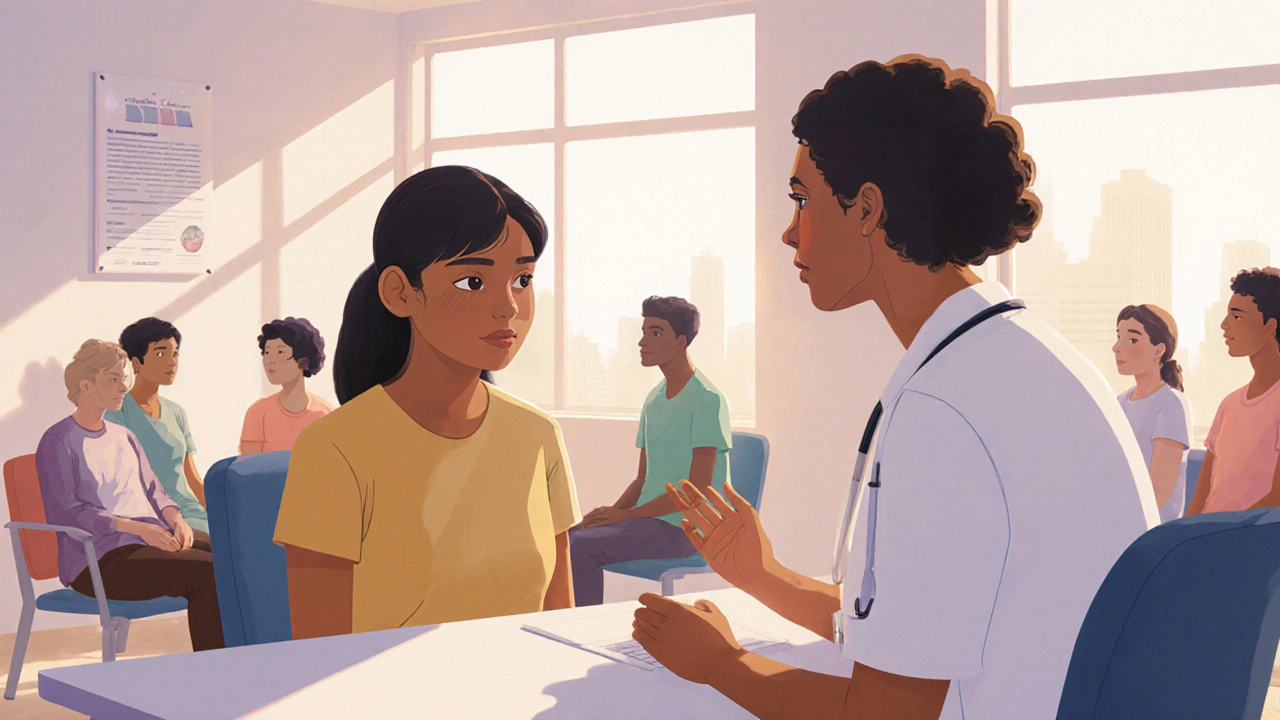Tuberculosis stigma keeps too many people from getting tested, treated, and supported. This article shows why stigma matters, busts the biggest myths, and gives clear steps you can take to create a more caring community.
Quick Take
- Stigma makes patients hide symptoms, delaying diagnosis by up to 6months.
- Myths about contagiousness, morality, and poverty drive fear.
- Education, empathetic language, and community champions cut stigma by 30% in pilot programs.
- Health‑worker training and policy support are essential for lasting change.
- Simple actions - listening, sharing facts, and protecting privacy - empower patients today.
What Is Tuberculosis Stigma?
When we talk about Tuberculosis is an infectious disease caused by the bacterium Mycobacterium tuberculosis, we often focus on lungs, cough, and medication. Stigma is a set of negative beliefs and attitudes that cause discrimination and social exclusion surrounds TB because of historic links to poverty, contagion, and moral judgment. In many societies, a TB diagnosis is still whispered about like a secret, leading patients to hide their illness, skip treatment, or even abandon their jobs.
Why Stigma Hurts Diagnosis and Treatment
Research from the World Health Organization (World Health Organization is the United Nations agency coordinating global health efforts) shows that in high‑burden countries, up to 40% of people with symptoms never reach a clinic because they fear being labelled. This delay means the bacteria have more time to spread and for the disease to become harder to treat.
Stigma also attacks treatment adherence. A six‑month course of first‑line antibiotics is already a challenge; add fear of being seen taking pills at work or school, and many patients miss doses. Missed doses fuel the rise of Multidrug‑resistant TB (MDR‑TB) is a form of TB that does not respond to at least isoniazid and rifampicin, the two most powerful anti‑TB drugs, which requires more expensive, longer, and side‑effect‑heavy regimens.
Myths That Keep Stigma Alive
| Myth | Fact |
|---|---|
| TB is always deadly. | With proper treatment, the cure rate exceeds 85%. |
| You can catch TB by sharing food. | TB spreads through airborne droplets when an infected person coughs or sneezes. |
| Only poor people get TB. | TB affects every socioeconomic group; crowded living conditions increase risk, not wealth. |
| TB cannot be treated if you’re an adult. | Adults respond just as well to the standard regimen as children. |
| Having TB means you’re morally weak. | TB is a bacterial infection; moral character has no role. |

How to Break Down Those Barriers
Changing attitudes requires a mix of education, empathy, and policy. Below are proven strategies that have moved the needle in places like India, South Africa, and the UK.
- Community‑led education. Workshops run by former patients and local leaders replace fear with personal stories. In Birmingham, a 2023 pilot saw a 28% drop in self‑stigma after a month of story‑sharing circles.
- Health‑worker training. When nurses learn to use non‑judgmental language (“You have an infection that can be cured”) and respect privacy, patients are 2.5times more likely to finish treatment.
- School curricula. Introducing age‑appropriate TB facts in primary school demystifies the disease early. The UK’s 2022 curriculum update includes a short module on “Infectious diseases and how we protect each other”.
- Media campaigns. TV spots that show everyday people getting screened normalize testing. A recent WHO‑backed campaign reduced avoidance behavior by 15% in high‑risk districts.
- Legal protections. Anti‑discrimination laws that cover health status prevent employers from firing TB patients, encouraging them to stay in care.
Policy and Public‑Health Programs Making a Difference
The World Health Organization sets global TB targets and guidelines has a 2025 “Zero Stigma” roadmap that urges countries to embed stigma‑reduction metrics into national TB strategies. In the UK, the Department of Health’s “TB Zero‑Stigma” initiative funds community outreach, supports patient advocacy groups like TB Alliance is an international nonprofit that accelerates research and development of new TB treatments, and mandates confidential contact tracing is the process of identifying and testing people who have been exposed to an infectious case for all confirmed cases.
Vaccination also plays a small but important role. The BCG vaccine is a live attenuated vaccine that protects against severe forms of TB in children is administered at birth in many countries; however, it does not prevent pulmonary TB in adults, so stigma‑reduction must go beyond vaccination coverage.
What You Can Do Right Now
- Speak the right words. Replace “TB patient” with “person living with TB”. Use “cured” instead of “cleared”. Language shapes perception.
- Share accurate facts. When someone mentions a myth, calmly correct it with a simple statement: “TB spreads through the air, not by sharing utensils.”
- Protect privacy. If you’re a coworker or teacher, keep health information confidential and only discuss it with consent.
- Encourage testing. Offer to accompany friends or family to a screening centre; a supportive companion reduces anxiety.
- Support advocacy groups. Volunteer, donate, or simply follow their social media for stories you can share.
Resources and Next Steps
Here are some trusted sources you can turn to for deeper information or local help:
- National Health Service (NHS) TB service offers free testing and counseling across the UK.
- TB Alliance provides patient stories, research updates, and ways to get involved.
- World Health Organization TB portal contains global guidelines, data dashboards, and policy briefs.
- Local community centres in Birmingham often host monthly “TB Talk” sessions; check your nearest council website for dates.

Frequently Asked Questions
Does TB only affect people in developing countries?
No. While the highest incidence rates are in low‑income regions, TB occurs worldwide. In 2023, the UK reported over 4,000 cases, mostly among people born abroad but also among native residents.
Can I get TB from someone who has completed treatment?
If treatment is successful, the bacteria are cleared from the lungs, so the person is no longer contagious. However, re‑infection can happen if exposed to a new source.
Is there a quick test for TB?
The most common rapid test is the GeneXpert MTB/RIF assay, which detects TB DNA and rifampicin resistance in under two hours. Traditional sputum microscopy takes longer and is less sensitive.
How long does treatment last?
Standard drug‑susceptible TB requires a six‑month regimen (two months of four drugs followed by four months of two). MDR‑TB can take 18‑24 months with second‑line medications.
What can I do to reduce stigma in my community?
Start conversations, share accurate facts, use respectful language, and amplify the voices of those who have lived with TB. Partner with local health services for education events and protect confidentiality when discussing health matters.


Comments
Great post on TB stigma it really opens up the conversation we need to have. I think the community stories are especially powerful because they give a human face to the data. We should all try to use the right language and remember that a person living with TB is just that – a person.
I totally agree with you lesion I think that showing empathy can benifit a lot. Everyone should be aware of the myths so we can stop the fear .
From a public‑health systems perspective, tuberculosis stigma operates as a sociocultural barrier that intersects with epidemiological determinants, thereby modulating both incidence and prevalence curves across heterogeneous populations. The pathogenesis of stigma is mediated by a confluence of risk perception, health‑literacy gaps, and structural inequities that perpetuate a feedback loop of marginalisation and delayed care‑seeking. Empirical studies employing mixed‑methods frameworks have elucidated that stigma correlates positively with reduced sputum‑culture conversion rates, ostensibly because non‑adherence leads to sub‑therapeutic drug exposure. Moreover, the diffusion of misinformation through informal networks engenders a diffusion of fear, which can be mathematically modelled using compartmental diffusion equations analogous to pathogen spread. In community‑engaged interventions, the deployment of narrative epidemiology-where former patients articulate experiential testimonies-has demonstrated a statistically significant decrement in self‑stigma indices, as evidenced by pre‑post Likert‑scale assessments. The linguistic reframing from “TB patient” to “person living with TB” aligns with the principles of person‑first language, mitigating attributive bias and fostering psychosocial resilience. Structural policy levers, such as anti‑discrimination statutes, operationalise the social‑determinants of health paradigm, thereby translating normative ethical frameworks into actionable health‑system reforms. It is also critical to address the occupational stigmatization of health workers, whose exposure risk perception can influence adherence to infection‑control protocols. Integrating culturally competent health‑communication strategies-leveraging local idioms and visual aids-optimises message salience across literacy strata. The scalability of such interventions is contingent upon cross‑sectoral synergies among governmental agencies, NGOs, and private sector stakeholders, each contributing to the resource pool and implementation fidelity. Furthermore, the adoption of digital health platforms for confidential symptom reporting can circumvent the visibility concerns that perpetuate stigma in workplace settings. Economic modelling suggests that each dollar invested in stigma‑reduction yields a multiplier effect on treatment success rates, thereby reducing the long‑term fiscal burden of multidrug‑resistant TB. In sum, dismantling stigma necessitates an interdisciplinary approach that synthesises behavioural science, health economics, and clinical epidemiology to achieve a holistic mitigation strategy.
The discourse presented, while commendable in its intent, overlooks the paramount importance of robust legislative frameworks that unequivocally protect individuals diagnosed with tuberculosis. Absent enforceable statutes, any educational endeavour remains a perfunctory exercise susceptible to regression. It is imperative that policymakers enact comprehensive anti‑discrimination provisions, thereby institutionalising the right to health.
When we contemplate the weight of stigma, we unearth a deeper truth: society often projects its own insecurities onto disease, treating it as a moral indictment rather than a biological inevitability. In this light, the path to healing transcends pharmacology; it demands a collective introspection that reconciles fear with compassion. Only then can we truly cure both the body and the spirit.
i cant disagree more i think the article overstates the role of laws and underestimates personal responsibility. people should just get screened instead of waiting for the gov to tell them what to do.
One practical step we can all take today is to listen without judgement when someone shares their TB experience. By validating their feelings and keeping their health information private, we create a safe space that encourages treatment adherence.
Honestly i think the stigma around tuberculosis is like a hidden beast that lurks in everyday conversations, and most folks dont even realise they are feeding it. When you hear someone say “that guy must have gotten TB because he lives in a poor neighbourhood”, you are instantly reinforcing a stereotype that has nothing to do with actual transmission dynamics. Its crazy how quickly we jump to moral judgments, like blaming the person for being “weak”. The truth is that TB is an airborne disease, and anyone in a crowded environment can catch it regardless of their moral fibre. I remember a friend who was diagnosed and he said the worst part wasn’t the cough, it was the whispered comments at work that made him feel like an outcast. That social isolation can actually derail the six‑month treatment plan, leading to drug resistance. So we really need to shift the narrative from blame to empathy, and that starts with simple language changes. Replacing “TB patient” with “person living with TB” is a small but powerful habit that signals respect.
Precisely, the terminology shift you mentioned is backed by WHO communication guidelines, which demonstrate measurable improvements in patient self‑esteem and treatment compliance when person‑first language is consistently employed.
The epidemiological landscape of tuberculosis is profoundly influenced by sociocultural determinants that extend beyond mere pathogen biology, encompassing variables such as socioeconomic status, urban density, and healthcare accessibility. Contemporary surveillance data reveal that regions with high population turnover exhibit not only increased transmission rates but also heightened stigma, which in turn impairs case detection. By integrating geospatial analytics with community‑based participatory research, public health officials can identify stigma hotspots and deploy targeted educational interventions. Moreover, the intersectionality of stigma with other health inequities, such as HIV co‑infection, creates compounded barriers that necessitate a multi‑layered response. Investment in capacity‑building for frontline health workers, focusing on communication skills and cultural humility, is essential for fostering trust among affected populations. The literature consistently underscores that when patients perceive their caregivers as empathetic and non‑judgmental, adherence trajectories improve significantly, reducing the incidence of multidrug‑resistant strains. Finally, policy coherence-aligning national TB strategies with broader social protection frameworks-ensures that stigma mitigation is not an isolated effort but part of an integrated health equity agenda.
I concur with the need for integrated approaches, and I’d add that community champions can serve as vital bridges between health systems and marginalized groups. Their lived experience adds authenticity to messaging, which often resonates more than top‑down directives.
Listen, reducing TB stigma isn’t just a nice‑to‑have-it’s a lifesaver. If we keep people scared, they won’t finish their meds and we get more resistant cases. So get out there, talk straight, protect privacy, and push for policies that back up those words. It’s time to stop whispering and start acting.
Sure, because shouting always solves problems.
What a fantastic initiative, indeed!; the emphasis on person‑first language, community engagement, and policy reform truly encapsulates a holistic strategy; kudos to all the contributors.
While the article sounds optimistic, we have to wonder who’s really funding these “community‑led” programs-big pharma, perhaps? Their profit motives could subtly shape the narrative, keeping us dependent on pharmaceutical solutions rather than genuine social change.
This is total drama, the whole stigma thing is like a soap opera that never ends; people get so caught up in the gossip they forget the real danger lurking behind the scenes-untreated TB.